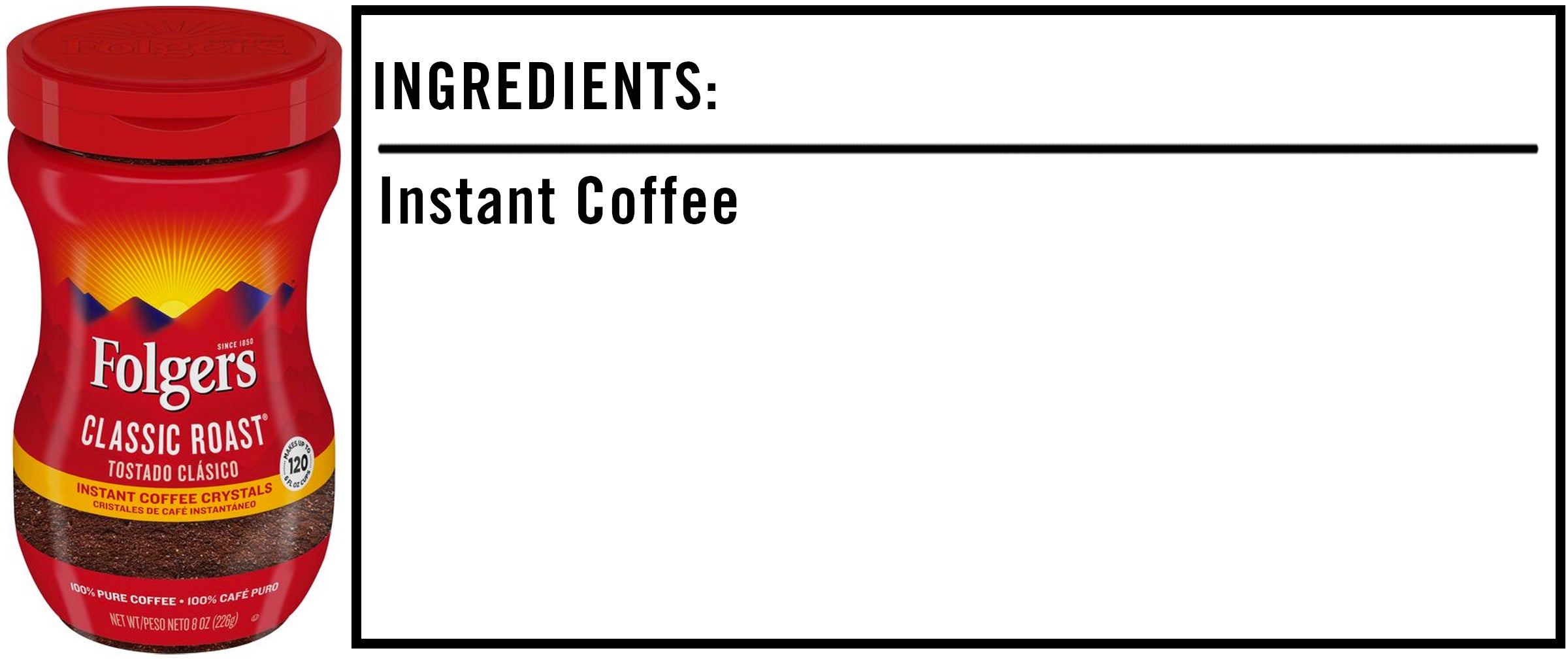We’re often told that you should never eat anything (or put anything on your body) if you don’t recognize everything on the ingredients list. But since most of us have no idea what xanthan gum or potassium benzoate are — or more importantly, what they’re doing to our bodies — we’re decoding the ingredients in the many things Americans put in (and on) themselves.
This edition: Folgers Classic Roast Instant Coffee Crystals, which are surprisingly made from only one ingredient that we’ve explained in extreme detail below.

The Ingredient
1) Instant Coffee: Yep, instant coffee is the only ingredient within this plastic Folgers tub. But it has quite a few interesting quirks, beginning with its production. See, there are two ways to make instant coffee. The first involves spritzing liquid coffee through fiercely hot air, which dries the droplets into a concentrated powder. The second is more complicated: Coffee beans are cooked into a thick extract, which is then frozen solid. Next, the ice within those frozen coffee cubes is vaporized by means of a chemical process known as sublimation, which leaves behind instant coffee granules without releasing pungent coffee aromas.
While that science is helpful for creating the simplest cuppa Joe ever, these processes have an adverse effect on both flavor and caffeine content. For example, your average cup of instant coffee usually contains anywhere between 30 and 90 milligrams of caffeine, whereas a standard cup of regular coffee might boast somewhere between 70 and 140 milligrams. Of course, too much caffeine is unhealthy, so do what you want with this information.
Another potential downside of instant coffee is that it can contain up to twice as much acrylamide, a cancer-causing chemical produced when coffee beans are roasted, than fresh coffee. That said, the amount one might consume through chugging instant coffee is almost certainly less than the doses that have proven to be harmful (unless you have an IV shooting instant coffee directly into your bloodstream, in which case, you could probably care less either way).
Instant coffee boasts some more impressive benefits, though. For instance, evidence suggests that it might contain more antioxidants than regular coffee, which is saying a lot considering coffee is arguably the largest source of antioxidants in the modern diet. These antioxidants help prevent numerous ailments, including heart disease, cancer and even type 2 diabetes. Furthermore, your average cup of instant coffee contains only four calories and provides small amounts of potassium (which supports our muscles), magnesium (which bolsters the immune system) and niacin (which assists with digestion).
Instant coffee sounds pretty damn good right now, huh? The same, however, cannot be said about Folgers as a brand — at least according to this Caffeine Informer list of brands you should avoid, where they roasted Folgers like coffee beans:
“This is a huge brand of coffees and is an iconic American brand. Although Folgers (J.M. Smucker) states on their website that they are concerned about sustainability and ethical working conditions, they reject all the common certifications to ensure this is happening.
“The coffee supply chain used is not pesticide, herbicide and fungicide free. They do not offer an organic variety and all their coffee is pre-ground and not fresh.
“Although this brand is cheap and convenient, you are getting a poor quality coffee.”
Eesh.
Seriously, though, studies suggest that the cheap coffee industry, much like everything else in late-stage capitalism, is worse for the environment than ever.
The Takeaway
Sure, we could talk shit about Folgers like every other coffee snob (we know, instant is crap compared to those fresh Colombian beans your buddy smuggled through customs in his prison pocket). But despite Folgers’ reputation for making cheap, shitty coffee, it’s actually better for your body. If only the planet were going to survive long enough for your body to enjoy it.

